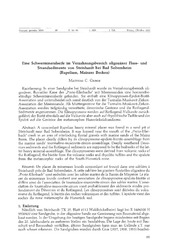Eine Schwermineralseife im Verzahnungsbereich oligozäner Fluss- und Strandsedimente von Steinhardt bei Bad Sobernheim (Rupelium, Mainzer Becken)
Zeitschrift: Mainzer geowissenschaftliche Mitteilungen, 200130: 81 - 90
Grimm, Matthias C., 2001: Eine Schwermineralseife im Verzahnungsbereich oligozäner Fluss- und Strandsedimente von Steinhardt bei Bad Sobernheim (Rupelium, Mainzer Becken). In: Mainzer geowissenschaftliche Mitteilungen, Band 30: 81 - 90, DOI: https://doi.org/10.23689/fidgeo-5571.
 |
Dokument öffnen: |
In einer Sandgrube bei Steinhardt wurde im Verzahnungsbereich oligozäner,
fluviatiler Kiese des „Proto-Ellerbachs” mit Meeressanden eine horizontbeständige
Schwermineralseife gefunden. Sie enthält eine Klinopyroxen-Epidot-Biotit-
Assoziation und unterscheidet sich somit deutlich von der Turmalin-Muskovit-Zirkon-
Assoziation der Meeressande. Als Muttergesteine für die Turmalin-Muskovit-Zirkon-
Assoziation werden tiefgründig verwitterte, devonische Gesteine und die Rotliegend-
Sedimente angenommen. Die Klinopyroxene werden auf Rotliegend-Vulkanite zurückgeführt,
der Biotit ebenfalls auf die Vulkanite aber auch aufrhyolithische Tuffite und der
Epidot auf die Gesteine der metamorphen Hunsrücksüdrandzone. Abstract: A concordant Rupelian heavy mineral placer was found in a sand pit at
Steinhardt near Bad Sobernheim. It was formed near the mouth of the „Proto-Ellerbach”-
creek in an area of interlocking fluvial gravels with marine sands of the Mainz
Basin. The placer clearly differs by its clinopyroxene-epidote-biotite-assemblage from
the marine sands’ tourmaline-muscovite-zircon-assemblage. Deeply weathered Devonian
sediments and the Rotliegend sediments are supposed to be the bedrocks of the latter
heavy mineral-assemblage. The clinopyroxenes were derived from volcanic rocks of
the Rotliegend, the biotite from the volcanic rocks and rhyolitic tuffites and the epidote
from the metamorphic rocks of the South-Hunsrück-zone.

